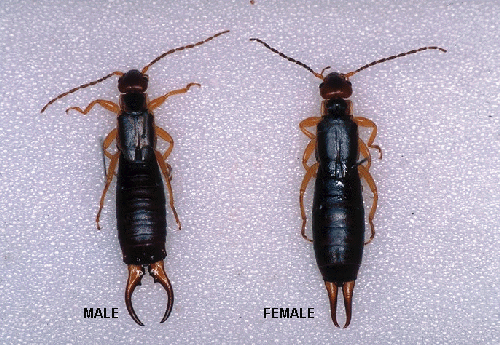Earwigs are unwelcome guests in most everyone’s garden or home. Earwigs can damage your plants, but they rarely bite people.

Source-ninnescahlife.wichita.edu
These ¾” long, reddish brown insects look particularly formidable, with their rear pincers and quick movements.
Their name comes from an old European superstition that these nocturnal insects will crawl into the ears, and then into the brains, of people while they sleep. (Remember the chilling scene from the movie “Star Trek: The Wrath of Khan”? Creepy, but pure fiction!)
Earwigs are native to Europe and were accidentally introduced to the US in the early part of the 20th Century. Since then, the population has spread quickly across the country.
Earwigs overwinter and lay their eggs in the soil. They hide during the day and come out at night to feed on insects and plants. Earwigs will eat aphids, mites, fleas and the eggs of other insects. But for most folks, the bad habits of earwigs outweigh the good. They’ll also feed on a variety of flowering plants and hostas, along with some garden vegetables.
They’ll hide under well caps, inside electrical outlets and any other dark place they can crawl into.
To control earwigs, some experts suggest removing possible hiding places from your yard to create a dry, sunny environment that earwigs will avoid. But if a dry, sunny yard is not your cup of tea, there are chemical and organic methods for controlling the nasty beasties.
Sevin and some other chemical insecticides will kill earwigs. Ask your local garden center what they have available for earwig control, and follow the directions on the package.
Insecticidal soaps kill earwigs on contact, and should be sprayed in the evening when the earwigs are active.
You can also trap earwigs by placing damp, rolled up newspapers overnight in the areas they frequent. Gather the newspapers in the morning and shake out any earwigs into a bucket of
soapy water. If earwigs get inside your house, just vacuum them up. They come inside to find a hiding place, but they do not breed indoors.
OMG. Yes, yes I do remember Star Trek: Wrath of Khan. I didn’t know which Star Trek movie it was, but I think about that scene every single time I hear the word “earwig.” I have referenced that scene so many times to friends and none of them has ever remembered it. I finally feel seen, LOL!
Hello,I recently bought a fireglow that is 2 years old and made from a graft instead of a seed. I don’t know if that makes a difference , but the soil it was ship in I change to a premix soil made by a company named tiny roots, for deciduous trees, was that a good move because it looks like two different kinds of soil. The soil it was ship in seems to hold moisture longer than the soil I change to witch dries faster. The problem I have is when I change the soil it was ship in I left some around the rootball because I was afraid to disturb the roots,then I used the tiny roots soil around the rest of the container not thinking at the time cause I’m. new to this, now when I check the soil around the rootball it’s moist but all around the rootball is dry, is that going be a problem can you give me some so much needed help if you do please send to my email address THANK YOU so much for your time
Bob,
I think you’ll be fine. Japanese maples hate to be too wet so water as needed but don’t over water. Once the roots reach out into the existing soil the soil that used to plant the tree isn’t going to matter. Most importantly, make sure the tree is not planted too deep and don’t over water it. The soil should be cool and moist to the touch, but not soaking wet.